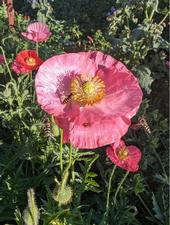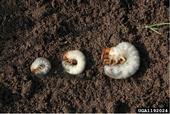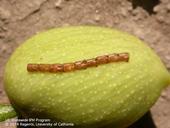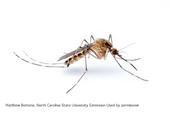- Author: Lauren Fordyce

There are many types of “good bugs” commonly found in the garden or landscape. In integrated pest management (IPM) we refer to “good bugs” as “natural enemies” or “beneficial organisms”. Natural enemies can include insects, but also mites, pathogens, and vertebrates like birds and lizards. They can kill or reduce pest populations by feeding directly on the pest, parasitizing the pest, or infecting the pest with a pathogen, reducing the need for pesticides.
Keep an eye out for the common natural enemies listed below and learn to recognize their egg and immature stages too!
- Author: Lauren Fordyce

While preparing your garden for planting this spring, you may have found white grubs in the soil. Discovering these fairly large, white grubs can be alarming, but they usually won't cause significant plant damage.
Grubs are the soil-dwelling larvae of beetles in the Scarabaeidae family, also simply called scarabs. They are generally curled in a C-shape with whitish bodies and 6 legs. Grubs of some species may be less than 0.5 inch long, while other species may be up to 2 inches. Some grubs feed on living plant material while others do not.
Masked chafer beetle grubs are often what people find in garden beds in California. If you find large grubs in compost, those are likely the larvae of the green...

Spring is here and if you are like us, you can't wait to get outside and see how your plants and garden are doing! As usual, UC IPM has useful tips for the month of April to prevent pests in the garden and landscape. To see more tips specific to your region, visit the Seasonal Landscape IPM Checklist on the UC IPM website. Here are some general tips to get you started:
- Cover fruit trees with netting to exclude birds and other vertebrate pests.

Below are answers to UC IPM's 2024 insect Easter egg hunt! Click on the name of each insect to learn more.
These eggs belong to the brown marmorated stink bug (BMSB) a pest of many types of plants and occasional indoor nuisance. BMSB females will lay up to 28 white or pale green eggs in a cluster. There are over 50 stink bug species in California, and some are beneficial predators of other insects while many like BMSB are pests that can damage plants.
- Author: Mackenzie Faith Patton

The invasive pest spotlight focuses on emerging or potential invasive pests in California. In this issue we are covering West Nile virus.
West Nile Virus Facts
West Nile virus disease was first reported in California in 2003 and has become the most common and serious vector-borne disease in California. With the exceptionally wet weather in 2023, reported cases of this mosquito-borne virus doubled compared to the previous year.
West Nile virus is spread by mosquitoes in the genus Culex. Usually, the virus passes between mosquitoes and birds, but mosquitoes can also transmit the virus to humans, horses, and other domestic animals.
Because mosquitoes can get the virus...


